Recognizing design excellence in geosynthetics
The International Achievement Awards, sponsored by the Industrial Fabrics Association International (IFAI), recognize innovation, technical skill and design excellence in geosynthetic applications.
The awards are an annual competition promoting awareness of the specialty fabrics used in thousands of products and applications ranging in size and shape. For more than 70 years, the awards have recognized innovation, technical skill and design excellence. Entries are judged by industry experts, editors, architects, educators and design professionals who were selected for their knowledge in a particular field of study or product area.
The association presented the awards in the Geosynthetics Products competition at IFAI Expo in Orlando, Fla. in October 2019. Categories included Mines/Landfills/Wastewater, Roadways/Infrastructure and Geosynthetics Miscellaneous, including the Best in the Geosynthetics Category overall from Hallaton Environmental Linings.
Award of Excellence | Geosynthetics Miscellaneous
Hallaton Environmental Linings
Druid Hill Reservoir: Temporary lined stone cofferdam
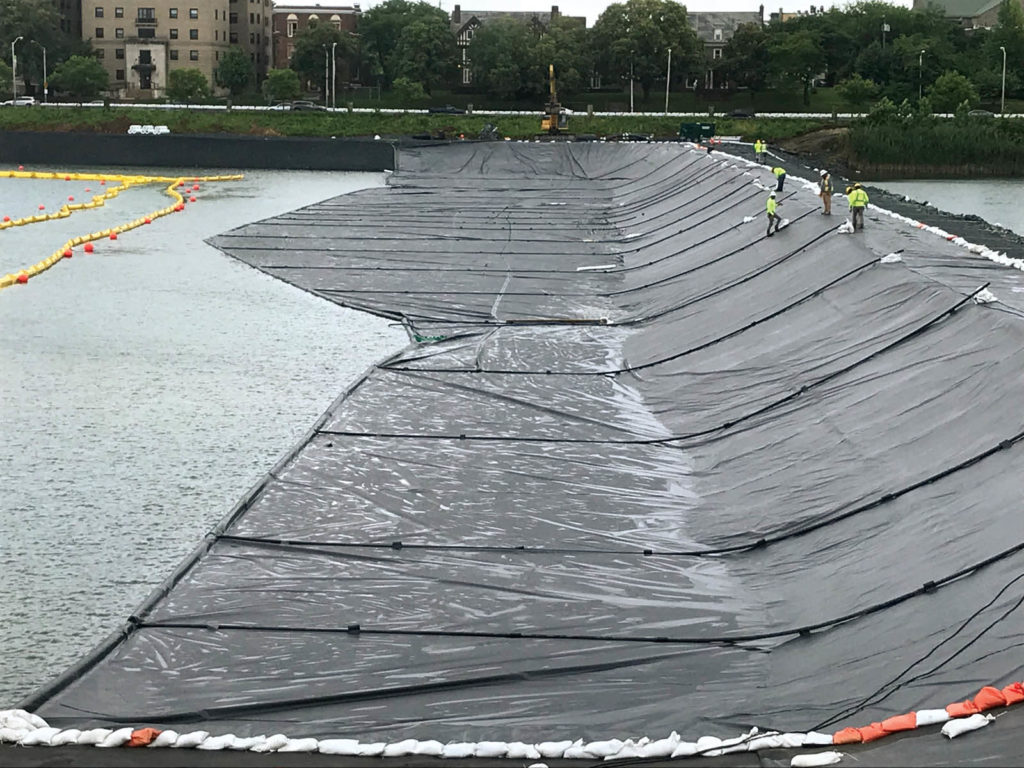
Project Highlights
Temporary lined stone cofferdam
Geomembrane producer and supplier: Seaman Corp.
Geocomposite producer and supplier: SKAPS Industries
Project manager and installer: Hallaton Environmental Linings
Geosynthetics products: XR-3 geomembrane Geocomposite
The purpose of the project was to construct a temporary lined stone cofferdam within the operational Druid Hill Reservoir in Baltimore, Md., in order to construct two new precast, prestressed water storage tanks (400–550 feet [122–168 m] in diameter) underground (Figure 1). The construction and installation of the lined cofferdam allowed the City of Baltimore to keep operational 49 acres (20 ha) of a 55-acre (22-ha) drinking water reservoir, while 6 acres (2 ha) of the reservoir could be dewatered behind the lined cofferdam to facilitate the construction of the underground storage tanks.
Following the contract award, the general contractor reached out to Hallaton Environmental Linings in 2017 about providing a geosynthetic liner solution for the temporary stone cofferdam. The lined stone cofferdam would be constructed in lieu of a more traditional sheeting barrier system that was part of the original bid documents. The general contractor and Hallaton, in conjunction with the supplier, proposed to install a temporary lining on one face of a stone cofferdam that was 1,200 feet (366 m) in total length. The stone cofferdam varied in depth based on the existing reservoir bottom ranging from 0 to 60 feet (0 to 18 m); thus, the depth of water varied in the area where the temporary cofferdam would be constructed. The general contractor and Hallaton consulted with an engineering firm to provide an engineering design for the proposed lined stone cofferdam concept.
With a design in hand, Hallaton chose an XR-3 8138 potable water-grade geomembrane liner manufactured by Seaman Corp. It met the requirements for potable-grade material; therefore, it was compatible with drinking water. Additionally, the XR-3 is puncture-resistant to survive the installation process with the angular riprap-type stone cofferdam. Another key factor in choosing the XR-3 geomembrane liner was its density. Its density is higher than water, which made it possible to sink the liner. Hallaton also proposed utilizing a double-sided geocomposite supplied by SKAPS to be installed directly on the stone cofferdam prior to installing the XR-3 geomembrane liner.
The crew installed the geocomposite on the top of the stone cofferdam and the leading face down to just above the existing waterline. The geocomposite could not come in contact with the water since it was not potable grade. The crew field fabricated panels of XR-3 in a staging area directly adjacent to the stone cofferdam.
The installed stone cofferdam varied in width and depth over the entire length; this presented a big challenge. Each XR-3 field-fabricated panel varied in length and had to be measured and cut precisely to ensure the leading edge of the cofferdam would be covered after the liner system was sunk below the waterline. Each panel length had to coincide with the exact width and depth of the stone cofferdam spanning the 1,200-foot (366-m) length.
One of the final challenges to ensure the successful installation of the liner system was the sinking of the liner. Based on the proximity of the turbidity curtains, the sinking of the installed liner system needed to be controlled from the stone cofferdam. A piping system fabricated and installed by Hallaton was crucial to sinking the liner.
Once the leading-edge liner system critical component was in place, the temporary stone cofferdam was ready to go into service. The general contractor installed additional stone ballast on top of the completed lined cofferdam, per design. Within a few days of completion, the general contractor readied the pumps to dewater the western side where the new underground tanks are to be constructed. This was the moment of truth. With the dewatering process underway, the water pumped from the western portion of the lake behind the cofferdam began to lower in level and the lined cofferdam held back the exposed water storage system. The overall Druid Hill Reservoir project is ongoing, with a scheduled completion date in 2021.
Outstanding Achievement | Geosynthetics Miscellaneous
TenCate Geosynthetics Americas
Kanai Resort shoreline protection and beach creation
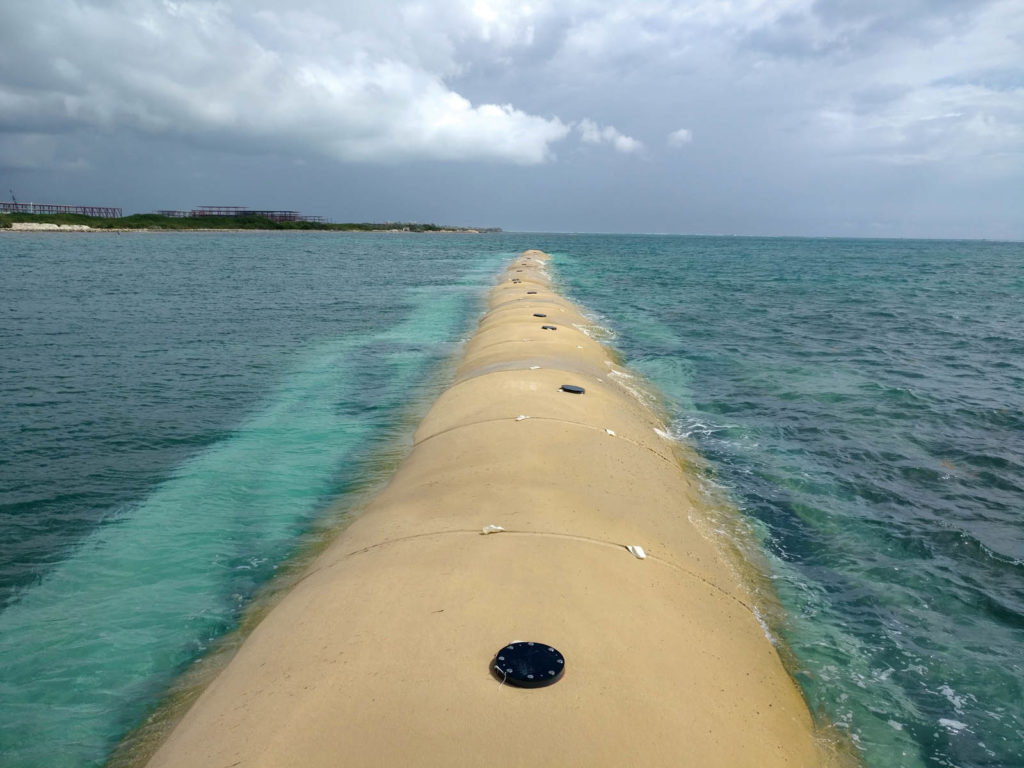
Project Highlights
Kanai Resort shoreline protection and beach creation
Geosynthetics Producer and Supplier: TenCate Geosynthetics Americas
Engineer: Ernesto Gray
Design: Tecnoceano
Installer: Control de Erosion
Geosynthetics Products: Geotube
The Kanai Resort is a 452-acre (183-ha) development along 1.1 miles (1.7 km) of coastline of the Caribbean Sea, 18.6 miles (30 km) south of Cancun, Mexico. The site is low-lying mangrove swamp without a sand dune or beach. The client wanted to create an artificial sand dune structure to serve as protection for the resort buildings and infrastructure. Therefore, the client also wanted a world-class 65.6-foot (20-m) wide gentle sloping white sand beach that could be protected by offshore breakwaters to create a calm shoreline environment for the resort guests (Figure 2).
The Kanai Resort shoreline protection project had three distinct phases to it utilizing TenCate GT500 Sand Color Geotube units and GC1200MB Composite Geotextile Sand Colored Geotube units. The first phase was to install a natural-appearing shoreline protection structure with a height of 8.2 feet (2.5 m) to protect the entire 1.1 miles (1.7 km) of the resort shoreline. Next, three 656-foot (200-m) long offshore breakwaters were installed, located 328 feet (100 m) offshore in 11.5 feet (3.5 m) of water. Lastly, a beach was created that had a minimum width of 65.6 feet (20 m) by dredging offshore white sand on the shore between the shoreline protection structure and the offshore breakwaters.
The natural coastline site of the Kanai Resort development was a flat mangrove swamp without any natural protection from the storms and hurricanes that routinely affect the western Caribbean and without a natural beach—a requirement of any Mayan Riviera resort. Therefore, the challenge was how to create a natural-appearing protection of the resort from storms and hurricanes, and how to provide the white sand beach environment with the same natural appearance and feel of a traditional Caribbean resort. The solution was to install sand-colored GT500 Geotube units that were filled with quarry-run course-grain material at the existing coastline. The oval-shaped 14.8-foot (4.5-m) wide Geotube structure would run the entire 1.1 miles (1.7 km) of shoreline and be installed to a height of 8.2 feet (2.5 m) and completed by covering with a veneer of white sand to provide the natural appearance of a coastal sand dune. Next, three 656-foot (200-m) long breakwaters were constructed in 11.5 feet (3.5 m) of water and located 328 feet (100 m) offshore. These breakwaters were created by installing a unique 2–1 pyramid design of sand-colored GC1200MB Composite Geotextile fabricated units. These Geotube units were installed using divers, with the quarry-run fill material being pumped from the shoreline. Finally, more than 10.5 million cubic feet (300,000 m3) of white sand was pumped onshore between the Geotube shoreline protection sand dune and the offshore Geotube breakwater structures.
Today, the Kanai Resort has a beautiful, natural-appearing, gentle sloping white sand beach where tourists can enjoy a calm and relaxing Caribbean Sea environment with the onshore property being protected by the 8.2-feet (2.5-m) high, 5,577-foot (1,700-m) long Geotube structure.
Award of Excellence | Roadways/Infrastructure
ACE Geosynthetics Inc.
Application of Geogrid Reinforced Structure for Abutment Protection in Taichung City, Taiwan
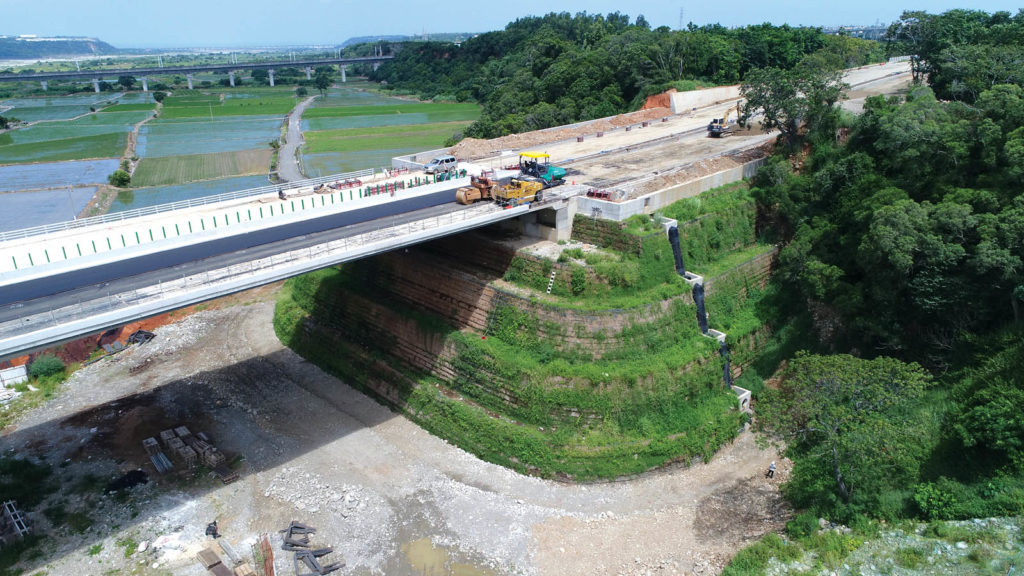
Project Highlights
Geogrid-reinforced structure for abutment protection in Taichung City, Taiwan
Geosynthetics Producer and Supplier: ACE Geosynthetics Inc.
Geosynthetics Product: ACEGrid
In order to make transportation of residents more convenient and diminish the heavy traffic flow that would be brought by the Taichung World Flora Exposition, the city government decided to build a connecting road with abutment for nearly 1.9 miles (3 km). The abutment is located at the toe of the slope, and large-scale excavation was necessary. If there was no protection to the surface of the slope during excavation, the slope would be likely to topple down due to rainwater or external forces and then endanger the safety of the abutment. For Taichung City to deserve the name of “Flower City” to enhance the local tourism industry, the city government wanted to make tourists feel free from the concrete jungle right after they exit the interchange. Owing to this requirement, the well-known wraparound, reinforced structure, which could be covered with green vegetation, was the most appropriate choice (Figure 3). The design adopted ACEGrid GG210-I and in situ excavated soils and rocks to build a retaining wall 65.6 feet (20 m) in height. There were four stages, and each stage is 16.4 feet (5 m) in height. A drainage facility was installed in every layer to accelerate water discharge in torrential rain. The structure is a U-shaped retaining wall that completely covers the rigid abutment.
Shengang Interchange goes through the south side of Shengang District only. Therefore, road users cannot use this interchange to access the Houli District by crossing the Dajia River.
The project features the U-shaped retaining wall to cover the abutment and protect the peripheral bare slope. The reinforced retaining wall increases the safety of the abutment, and the wall surface helps to resist the scouring to the slope brought by rainwater and external forces. The durability of materials offered by ACE Geosynthetics is excellent and with low creep to diminish the deformation of structure. There is no stress concentration problem in reinforced structures. The feature is especially suitable for Taiwan, which is in an area of frequent earthquakes. The solution is cost effective and eco-friendly, and features pleasant landscaping. The installation process was simple and short, and installation quality could be controlled easily.
The city government is satisfied with the structure. It shortens the drive from a rural area to downtown by 45 minutes. The results can be reviewed in the following aspects:
- Safety: The structure strengthens the stability of the abutment’s foundation and the slope simultaneously.
- Cost-effectiveness: Large amounts of excavated soils and rocks are filled back into the reinforced structure, slashing the cost drastically.
- Eco-friendliness: Green vegetation on the surface of the reinforced wraparound structure is integrated harmoniously into the natural surroundings and beautifies the abutment. The surface of the structure turns exuberant green within one year of project completion. Adopting in situ soil and rocks in the reinforced retaining wall helps to lower the cost of delivering waste soils and reduces the risk of polluting the environment.
Outstanding Achievement | Roadways/Infrastructure
TenCate Geosynthetics Americas
Davao City Coastal Road Project
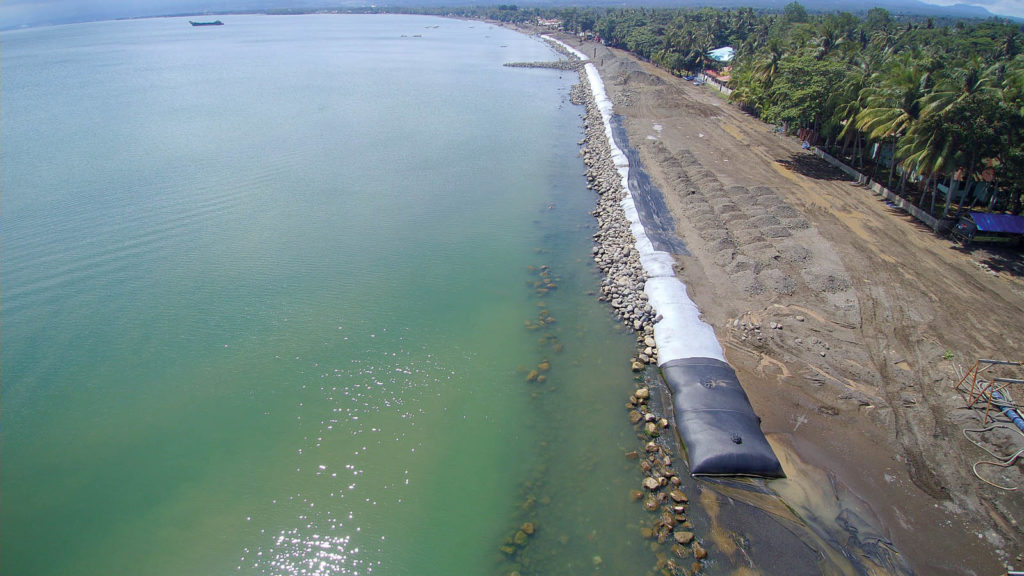
Project Highlights
Davao City Coastal Road Project
Geosynthetics Producer and Supplier: TenCate Geosynthetics Asia
Engineers: Regional Director Allan S. Borromeo/Engineer Teofila U. Tan
Design: DPWH Region 11 Planning and Design Division
General Contractor: DPWH Region 11 Construction Division
Installers: RELY Construction and Supply, Hi View Resources and Development Corporation, Wee Eng Construction Inc., Ulticon Builders Inc.
Geosynthetics Products: Geotube, Mirafi, Polyfelt PEC
Traffic volume in Davao City, Philippines, has been increasing recently due to population and economic growth. In the inland part of the city, most people depend on vehicular public transportation services such as jeepneys, tricycles and buses, which contribute to the worsening traffic congestion. The Davao City Coastal Road aims to abate and address the traffic congestion in the city by diverting private vehicles from passing through the downtown area. The project will also improve interregional transport of goods and services passing through the city, as well as support the growth of the agro-industrial sector. Apart from that, the project aims to serve as a tourism facility as esplanades, where parks, playgrounds, an outdoor theater and botanical gardens shall be constructed.
The first of the five segments of the project, Segment A, covers 1.1 miles (1.7 km) along the coastline, costing PHP 1.96 billion (US$38.79 million). The project started in September 2017 in Talomo, Davao City. The initial phase of the project consisted of reclaiming 98 feet (30 m) from the existing shoreline in order to construct a stable working platform for the coastal road project. Reclamation works were done using TenCate’s Geotube systems (Figure 4). Geotube GT750M geotextile tubes replaced the conventional laying of boulders, as there is scarcity in the supply of armor rocks in the region. In situ sand filling of the geotextile tubes offers both a more economical solution with guaranteed speedy construction of the seawall, compared to the conventional method of importing core rocks using barges, and a more environmentally friendly solution with less carbon emissions due to less import material being required. The sandy materials dredged in the area were also used in filling the tubes, which made the project more economical.
Initial works of the project consisted of furnishing and laying the GT750M geotextile tubes using A-frames for alignment in order to serve as an edge dike and revetment protection. The geotextile tubes were filled hydraulically to 6.56 feet (2 m) high, 82 feet (25 m) length and 41.34 feet (12.6 m) circumference by pumping sand slurry through the filling ports. To allow flow of fill material, the fill was in the form of sand/seawater slurry. The GT750M geotextile tubes, being permeable, allowed the water to pass through the fabric while the sand was being retained inside the tubes. Prior to the filling the embankment of earth fill, Mirafi® FM2000 woven filter geotextiles were installed to serve as a basal reinforcement of the structure. To make the tubes a permanent mass gravity structure, a layer of Polyfelt® F68 filtration geotextiles was laid to protect it from punctures from the overlying boulders.
The installation of the geotextile tubes in Segment A of the project is completed. The flexibility of geotextile tubes sped up the completion time of Segment A with less labor required, due to the mechanical method of installation. The output of the project made an impact with other Department of Public Works and Highways (DPWH) regions and district offices. New coastal road projects in the Philippine cities of Davao Oriental, Butuan City, Cagayan de Oro and Leyte are being designed using geotextile tubes.
Outstanding Achievement | Roadways/Infrastructure
TenCate Geosynthetics Americas
Price River Terminal–Rail Settlement Mitigation
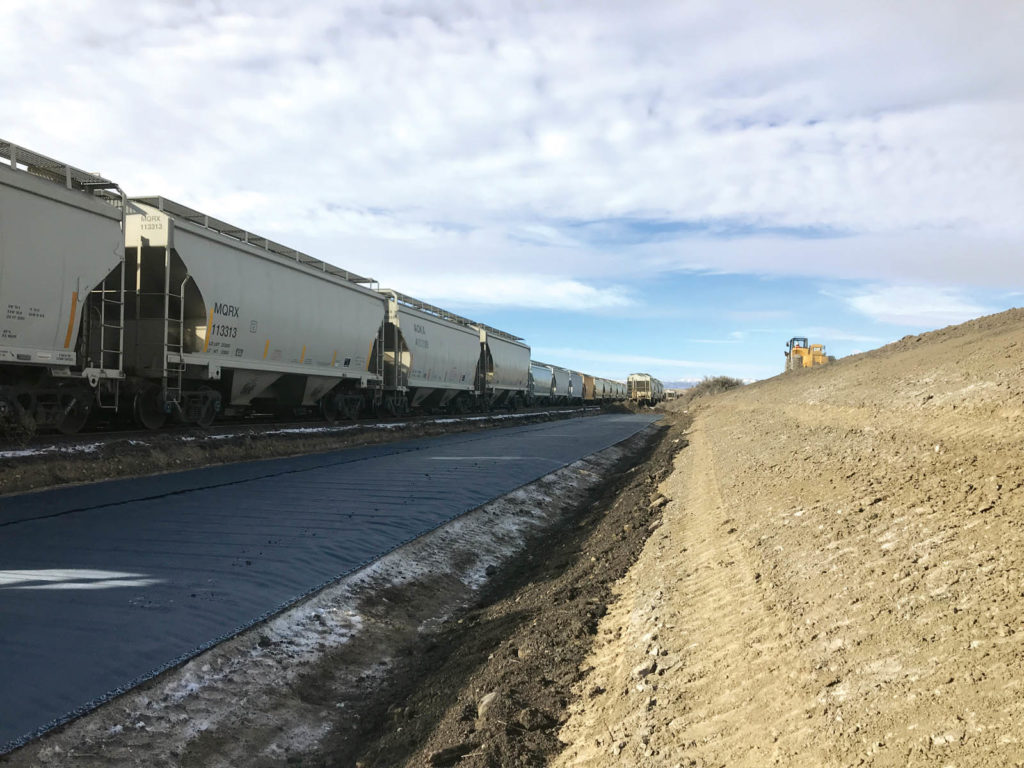
Project Highlights
Price River Terminal—Rail Settlement Mitigation
Geosynthetics Producer, Supplier and Fabricator: TenCate Geosynthetics Americas
Engineer: Johansen & Tuttle Engineering
General Contractor: Mountain States Contracting
Project Manager and Installer: Neilson Construction
Geosynthetics Product: Mirafi
The Price River Terminal in Wellington, Utah, is the Uinta Oil Basin’s newest crude-by-rail transloading facility. During a portion of the rail extension project, soft clay and silt subgrade were encountered. Exacerbating the poor soils, a retention basin located uphill from the current project area was known to leak and saturate the soils downhill. These soils had the potential to shrink and swell during periods of saturation and drying. The owner was primarily concerned that the need for continuous maintenance of the track and differential settlement would waste valuable resources and could pose a major safety concern.
Differential settlement of the track posed both a safety concern and a continuous expense required to maintain acceptable track alignment. The project team members had explored various options to mitigate rail settlement, but none of those options provided the long-term solution they were seeking. The project team requested a continuous defense against moisture accumulation below the track surface. The geotechnical engineer determined that subgrade stabilization and a moisture management system were required for successful mitigation of differential settlement concerns.
Construction took place during winter months and the soil was frozen and difficult to move and place, indicating a high moisture content. The project team was searching for a solution that could help remove the water in unsaturated conditions. Previous studies conducted by other entities and TenCate Geosynthetics proved that reducing moisture in soils that have the potential to swell and shrink can reduce differential settlement by creating a more uniform moisture content. Mirafi H2Ri was selected and the constructed solution was placed directly above the existing subgrade, 6 inches (15.2 cm) of subballast and 15 inches (38.1 cm) of ballast (Figure 5). The H2Ri system also served as an active moisture management system, reducing the overall moisture content through continuous moisture reduction. In addition, the H2Ri provided separation between the fines in the subgrade soils and the ballast, confinement to prevent lateral spread of the ballast, and high tensile reinforcement to improve the overall capacity of the section to support railroad loading.
The project team members expressed that during their discovery phase of evaluating different options, they did not find any other solution to keep them on schedule and provide a long-term solution to alleviate differential settlement concerns. The contractor noted that installation was simple, and since they included a separation geotextile below the ballast in their original plans, the installation of the H2Ri did not add any additional construction time or cost to the project. The only additional cost was the material itself, which provided significant savings over the alternative of over-excavating and bringing in stronger fill material. The project was an overall success during installation and during its first thaw cycle in spring 2019. Rail alignment/settlement and performance will continue to be assessed in years to come.
 TEXTILES.ORG
TEXTILES.ORG


